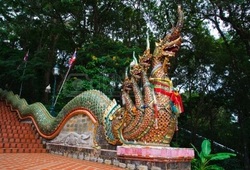 An observant student from the USA in the Go-Ed program pointed to the bottom step leading up to a Buddhist temple building and asked, “Why is that snake coming out of the mouth of the other one?” It’s taken some study, but I hope he’s online because I have the answer now. The multi-headed serpent was a naag. A naag is a mythological creature sometimes characterized as a cobra, sometimes a many-headed reptile, but usually as a dragon with one or multiple heads. The naag in Buddhist lore is venerated for several reasons, the chief one being that it was the naag who protected the Buddha when he was being attacked by demonic forces. Seeing the advancing army of evil, Mother Toranee (read: Mother Nature) wrung out her freshly shampooed hair causing a flood that delayed the demons long enough for the forces of good to counter-attack. The naag lifted the entranced Buddha upon her coils above the flood and covered him against the deluge with her hood (or her many heads). Much less well-known is the identity of the other reptile out of whose mouth the venerable naag is emerging along the stairways of almost every temple in Thailand. That is Sheshanaag, also known as Anata Shesha or Makara. Sheshanaag was the couch or raft upon which Vishnu reclined on the cosmic sea of milk before the formation of the earth. Sometimes Makara is portrayed as a cobra, a crocodile, a fish with an elephant head, or a lizard-like dragon. In some temples, such as in the one pictured above of the long stairway leading up to Wat Doi Sutape here in Chiang Mai, there is a crocodile under the naag in addition to the dragon disgorging the naag. That underscores my contention that Sheshanaag and Makara are one and the same. These sorts of investigations are intellectually stimulating, but what does it mean that Sheshanaag produced the naag? The main thing is the clear connection between Hinduism and Buddhism. The symbolism says Hinduism gave birth to Buddhism. Or, if you prefer, Buddhism emerged from Hinduism. This is not denied by anybody, but it seems well to reiterate it anyway. Nor, on the other hand, did this happen in some epic battle as Greek, Egyptian and Babylonian mythologies contend, whereby the previous generation was savagely defeated. The naag is a continuation of Sheshanaag, who can be seen rippling along the crest of the temple roof on the threshold between earth and heaven. In Thai Buddhism, statuary is one of the languages of the lore. If we read it this way, Buddhism is proclaiming that the truth, the Dharma, is connected to, and to an extent emerges from, prior truth. Truth from truth all the way back to the cosmic sea of milk, or tohu-wa-bohu (Genesis 1:1-2), or whatever you prefer. I’ll go with big bang and a billion-degree sea of fire.
0 Comments
Leave a Reply. |
AuthorRev. Dr. Kenneth Dobson posts his weekly reflections on this blog. Archives
March 2024
Categories |
| Ken Dobson's Queer Ruminations from Thailand |
|
 RSS Feed
RSS Feed
